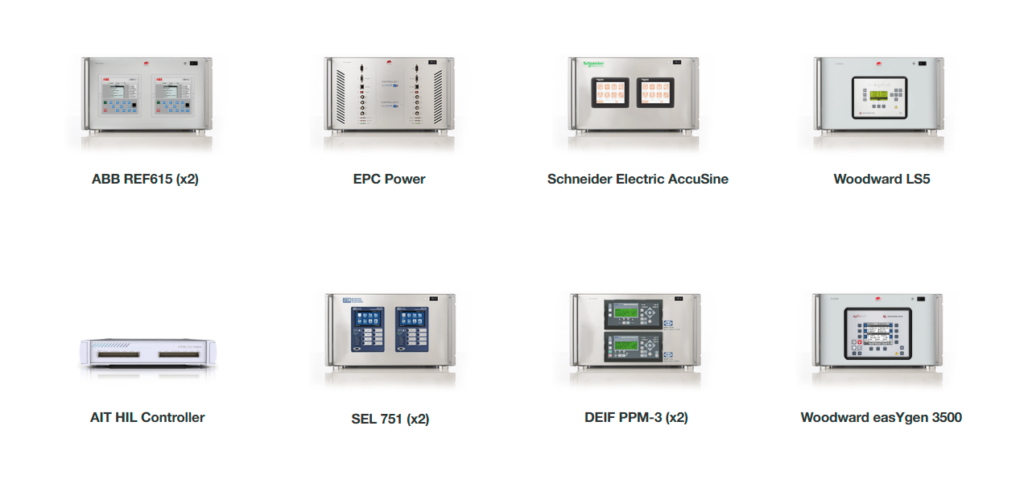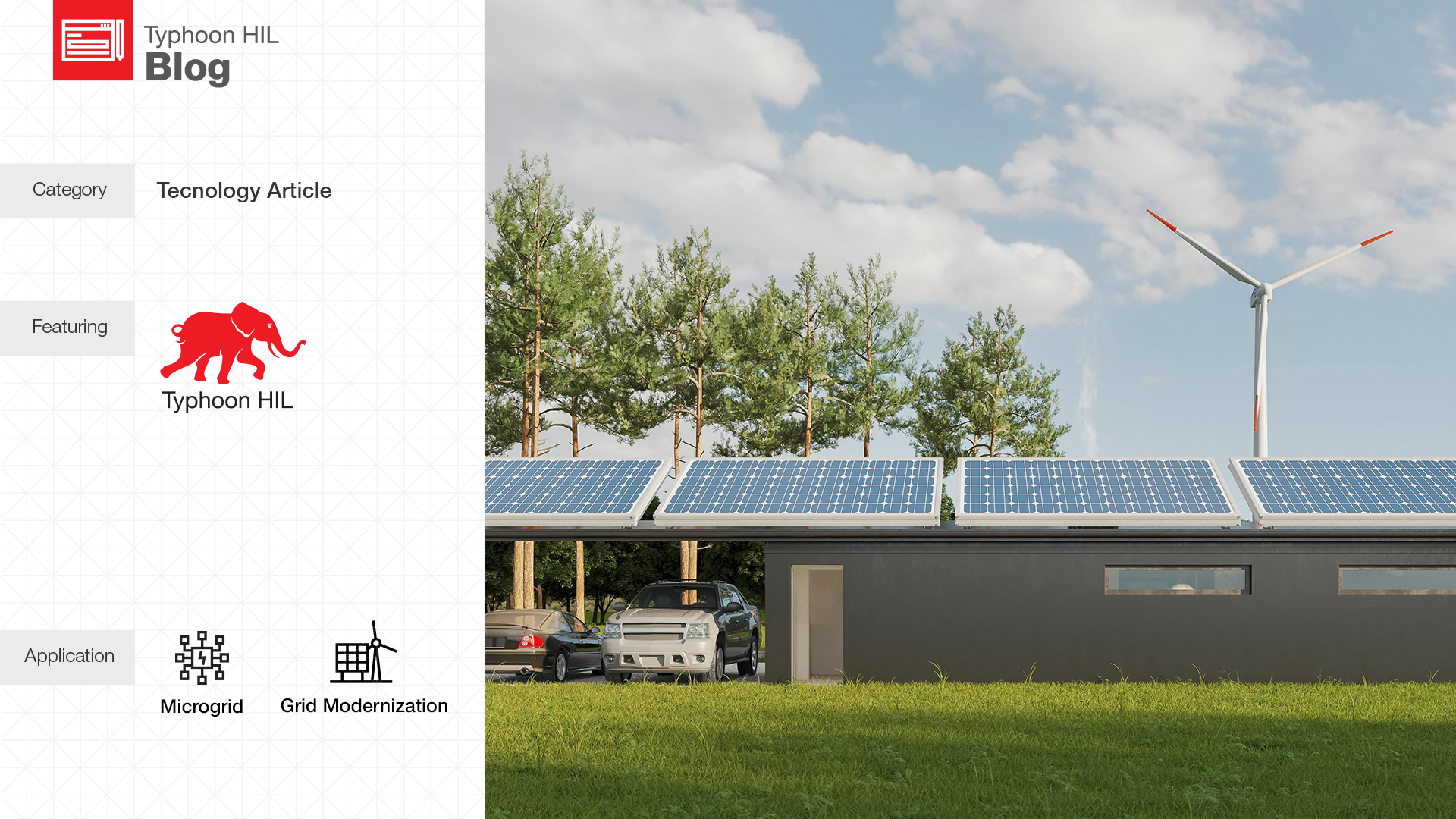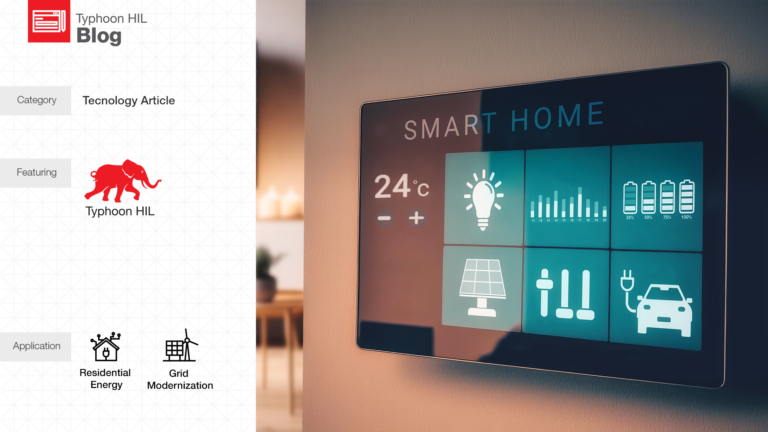Introduction | The Role of Microgrids
Microgrids have become a cornerstone of modern energy systems, blending decentralized energy generation with advanced control techniques to enhance reliability, sustainability, and flexibility. They offer the distinct advantage of operating independently in islanded mode or seamlessly integrating with the main grid, providing also grid support services. However, achieving their full potential presents significant challenges, including the complexity of managing diverse Distributed Energy Resources (DERs), ensuring power quality and system stability, and navigating transitions between operational modes. To address these demands, advanced control strategies and rigorous testing frameworks are critical, with Hardware-in-the-Loop (HIL) technology emerging as a transformative solution.
Control Strategies | Ensuring Optimal Microgrid Operation
The operation of microgrids is a balancing act. Each component—from gensets and photovoltaic inverters to batteries and supervisory controllers—plays a crucial role, requiring precise coordination to achieve stability and efficiency. Effective microgrid management ensures an uninterrupted power supply, adapts to dynamic load changes, provides grid support, and optimizes resource utilization. Whether operating in islanded mode or connected to the grid, these systems must be robust enough to handle faults, maintain voltage and frequency stability, and meet diverse energy demands.
Control strategies for microgrids have advanced significantly in recent years. Techniques such as droop control enable decentralized voltage and frequency regulation but require fine-tuning to address challenges like current sharing and voltage drop. Virtual synchronous generators offer another approach, emulating the inertia and damping properties of traditional rotating machines to enhance stability. Meanwhile, dispatchable virtual oscillators offer a decentralized solution tailored for grid-forming applications, ensuring global stability even in complex configurations. These strategies reflect the increasing sophistication required to manage the intricate dynamics of modern microgrids.
Most microgrid designs today integrate elements of centralized and distributed control, striking a balance between redundancy, cost, and system complexity. Centralized supervisory controllers provide an overarching management structure, while distributed control ensures that individual DERs can operate independently when needed. This hybrid approach is particularly valuable in addressing the interoperability challenges posed by legacy and newly integrated DERs. Aligning control algorithms, ensuring compatibility across devices, and managing communication between components are all critical tasks that underscore the importance of rigorous system testing.
HIL Testing | Control Validation with Hardware-in-the-Loop
Imagine validating complex microgrid systems without the high costs and safety risks of traditional testing. HIL simulation makes this possible, revolutionizing how engineers design, test, and refine controllers. By replicating real-world conditions in a virtual environment while preserving the integrity of the real device under test, HIL ensures accuracy and reliability, bridging the gap between theoretical design and practical implementation. This approach facilitates exhaustive testing across a wide range of scenarios in an automated fashion, from steady-state operations to extreme fault conditions, empowering engineers to refine control algorithms and validate system performance with unparalleled accuracy.
HIL simulation offers transformative benefits beyond cost savings and safety improvements. It accelerates development timelines by enabling continuous testing of control software, enabling engineers to iteratively validate and refine their controllers in real time. By integrating real controllers with high-fidelity, real-time simulations of physical systems, HIL ensures that even highly dynamic and complex interactions between components are accurately captured. This capability makes HIL indispensable for applications involving renewable energy integration, power electronics, and microgrids, where system performance and reliability are critical.
Furthermore, HIL simulation streamlines the testing process by reducing the reliance on costly high-power physical setups during the development stages. Additionally, the risks associated with high-voltage testing are avoided. For power systems engineers, HIL empowers the exploration of edge cases and stress conditions that would be too expensive or dangerous to recreate in physical labs, ensuring system performance and robustness before deployment.
With Typhoon HIL’s vertically integrated toolchain, engineers can streamline workflows, achieve ultra-high simulation fidelity, and unlock the full potential of their designs – so it is no surprise that Typhoon HIL’s innovative solutions have been at the forefront of this testing revolution. The Typhoon HIL Control Center software toolchain, with features like custom user interfaces and programmable test sequences through TyphoonTest and Typhoon Test Hub, simplifies the microgrid validation process. By enabling automated, unsupervised simulations, these tools shorten development cycles and enhance the reliability of control systems. This testing environment not only improves the compatibility of diverse DERs but also supports the seamless integration of renewable energy sources – a critical factor in advancing global sustainability goals.
HIL Compatible | Harnessing the Power of Digital Twins
As microgrids evolve, they present new challenges and opportunities, including standardizing communication protocols, enhancing cybersecurity, and integrating legacy DERs with modern systems. These challenges demand innovative solutions to ensure microgrids remain resilient, forward-looking, and pivotal in advancing decentralized, sustainable energy systems. Their capacity to integrate renewable sources, enhance grid resilience, and deliver reliable power makes them indispensable in the global energy transition.
In this context, Typhoon HIL’s lineup of HIL Compatibles enables Original Equipment Manufacturer (OEM) controllers to be quickly and easily integrated into a larger HIL testing system. HIL simulation, augmented by HIL Compatibles, delivers unmatched fidelity for effectively verifying system behavior, testing interoperability, and successfully commissioning and maintaining a wide range of assets through their lifecycle, ultimately reducing risks and accelerating the development of sophisticated microgrid systems.

Typhoon HIL’s growing HIL Compatible product line (see Fig. 1) exemplifies the potential of productized digital twins. By enabling effortless integration into HIL testbeds, these tools support electrical connectivity, communication protocols, and data exchange with minimal setup. This approach reduces costs, enhances reliability, and accelerates project timelines. From early design validation to operational support, HIL empowers engineers to address today’s challenges while building a sustainable energy future.
Conclusion | The Future of Microgrids
Microgrids represent the cornerstone of a sustainable energy future, enabling resilience, decentralization, and renewable integration in power systems worldwide. As the energy transition accelerates, the evolution of microgrids is driven by the convergence of advanced control systems, robust testing methodologies, and cutting-edge educational resources. Typhoon HIL and HIL Academy are at the forefront of this transformation, equipping engineers with the tools and knowledge to navigate the complex challenges of modern energy systems while harnessing their potential for global sustainability.
Engineers can stay ahead in this dynamic field by leveraging resources such as Typhoon HIL’s educational initiatives. Courses offered by HIL Academy — like HIL for Microgrids by Typhoon HIL engineers, Control of Microgrids by the Federal University of Santa Maria (UFSM) and University of Illinois Urbana-Champaign, Digital Control of Grid-Tied Converters by UFSM, and HIL Simulation for Power System Protection by Industrial Technical College in Santa Maria (CTISM) — provide valuable insights into control techniques, protection schemes, and testing methodologies, equipping participants with the skills needed to address real-world energy challenges.
With the tools and expertise offered by Typhoon HIL and HIL Academy, engineers are well-equipped to lead this transformation, ensuring that microgrids deliver on their promise of sustainability and reliability. The Typhoon HIL Forum also opens an opportunity for the entire HIL community to discuss topics and seek assistance in resolving specific challenges, fostering collaboration and innovation in this critical domain.
Additional Resources
Credits
Authors | Debora Santo, Caio Osorio
Visuals | Milica Obradovic, Karl Mickei
Technical Editors | Luka Jovancic, Caio Osorio
Blog Editors | Debora Santo, Dovlyn Curtis, Sergio Costa



